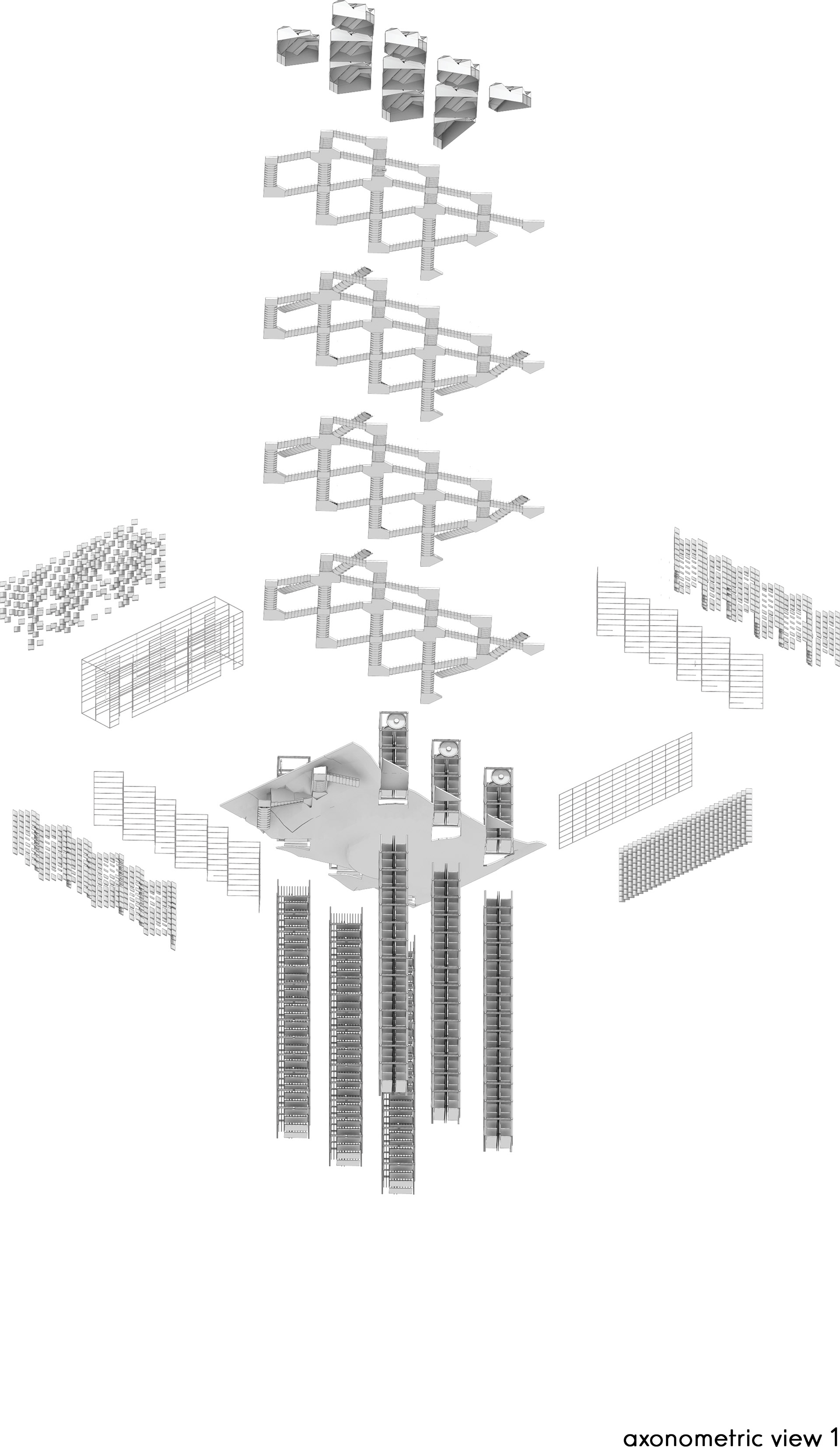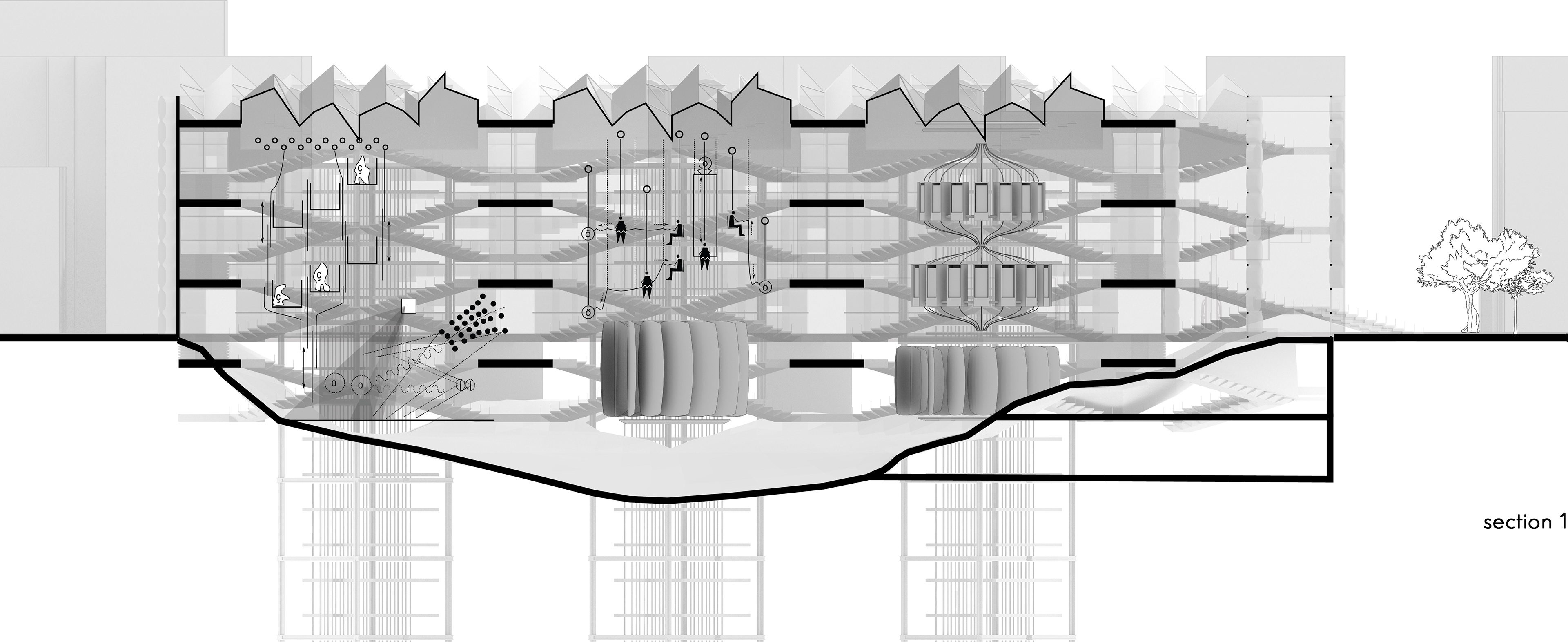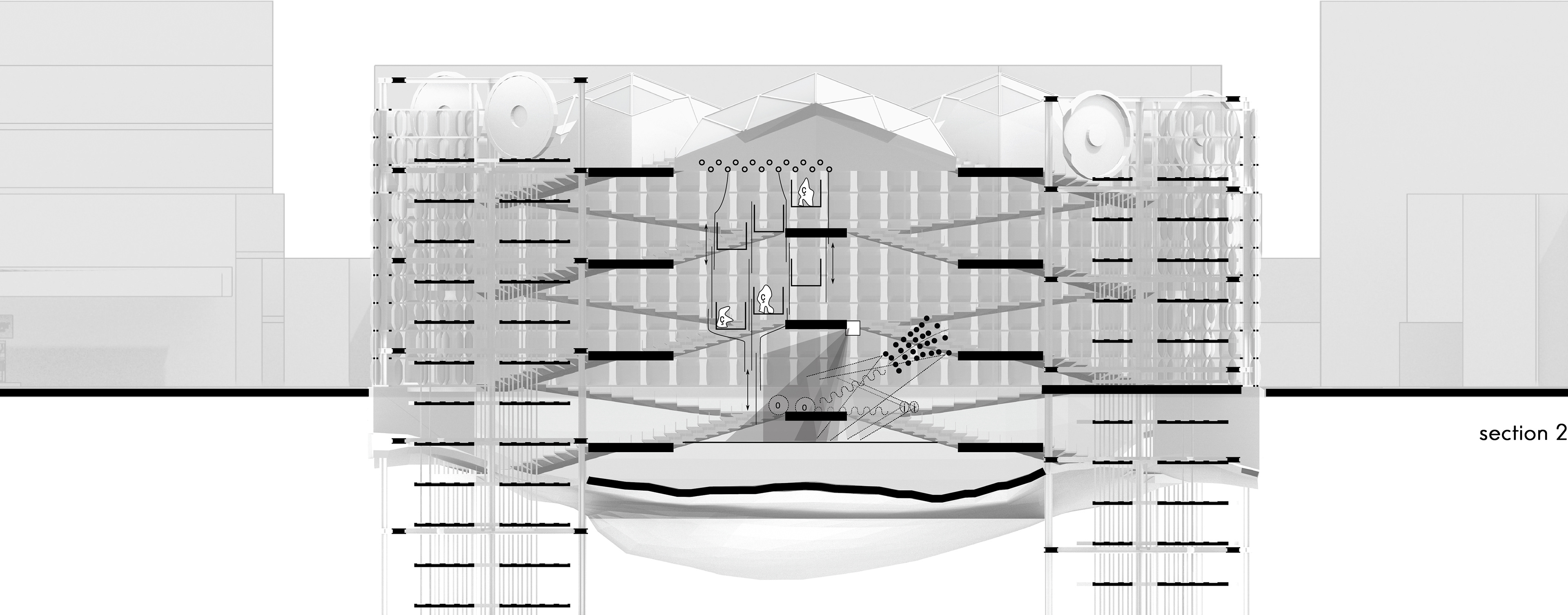The project was produced within the scope of the national architectural project competition. In addition to being an architectural project, it is also a research project. An in-depth research was conducted on the architectural program and the environment, and a large number of texts and ideograms were produced in line with the information obtained. I had the opportunity to be involved in this entire research and production process throughout the competition calendar. Some of the texts, ideograms, diagrams, collages and other architectural representations produced were produced by me personally. I contributed to other materials produced within the scope of the study by generating ideas and drawing.
This study explores a posthuman architectural scenario through architectural media. Developments in complex systems, biotechnology, cognitive sciences, artificial intelligence, and robotics; transformations of understandings in social and human sciences; questions concerning singularity, acceleration, transhumanism, posthumanism, cyborgs, queer theory, social identity, and personal identity promise us novel understandings on what the human is and what it may become. This is to change how we understand and practice architecture, which has come to appreciate itself in a deeply human centered way. We present a series of examinations on a set of architectural programs including shopping center, food courts, cinema, theater, administrative units, hobby areas, and car parking. Each of these programs was considered as a semi-independent case, to be dispersed within the volume of a building where both interior and exterior walls are dissolved. Our basic method is to expose the latent systemic relationships, which is followed by a spatial and functional reappraisal of the ceremony, i.e. program. A secondary tactic is the alienation effect obtained through a gradual intermingling of casual and posthuman understandings. We intend to demonstrate that a posthuman reappraisal of architectural situations would entail a subtle, yet thorough revision of how we develop and maintain spaces.
Illusions of spontaneous subjects against inertial objects; ontologies based on a duality between a formative principle against amorphous matter; the hierarchies that were assumed to exist between living things and systems, and the folk sciences that we happen to be caught in seem to have come to an end. While systemic, ontological, and ethical pluralism impose the condition of nonidentity, a systemic perspective offers an interactive picture of objects, energy, and information. On a higher level, the process of individuation appears as a combination of various social, economic, and cultural systems that run, operate, and describe it.
Various architectural theorists and practitioners have already started to explore this systemic outlook of cities and their interactions with individuals, or their indifference to humans. However, beyond the systemic city, developments in complex systems, biotechnology, cognitive sciences, artificial intelligence, and robotics; transformations of understandings in social and human sciences; questions concerning singularity, acceleration, transhumanism, posthumanism, cyborgs, queer theory, social and personal identity present us a whole new geography of understandings on whether the human ever was, if so, what it was, and what it could become. Novel answers in this quest will inevitably change how we understand and practice architecture, which has come to appreciate itself in a deeply human centered way; hence the urgency in understanding and constructing the posthuman.In this study we have examined a group of programmatic setups as the symbolic ceremonial set of posthumanity, so that we can explore the above mentioned issues. Each of these programs was considered as a semi-independent case, to be dispersed within the volume of a building where both interior and exterior walls are dissolved. Our basic method is to expose the latent systemic relationships, which is followed by a spatial and functional reappraisal of the ceremony, i.e. program.
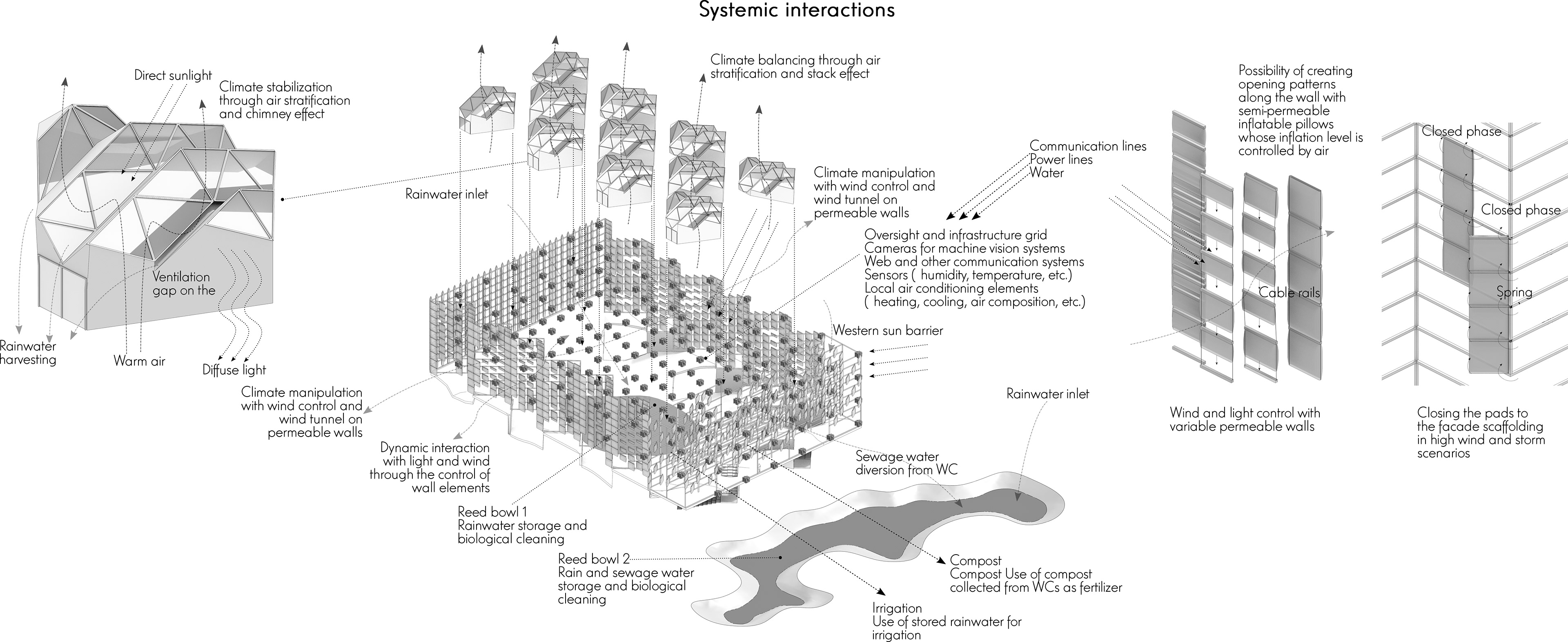
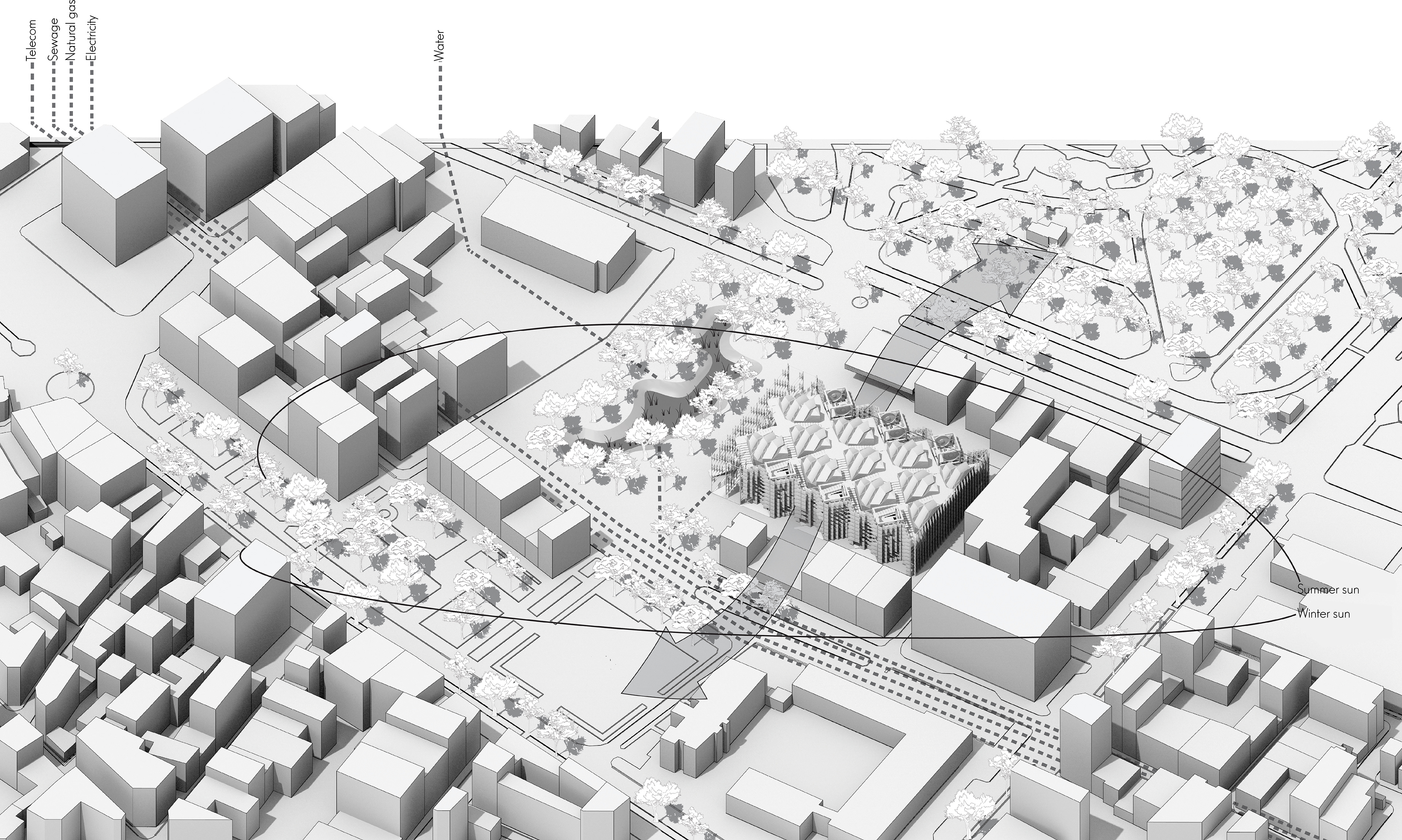
Examination of food court area and programs
In the shopping centers, eating and drinking areas are connected to two separate overall systematics. The first is related to meeting, gathering, waiting, and time wasting while the other connects us with systems of various scales ranging from biological ecosystems to macroeconomics, from cultural areas to industrial production and transportation.
While organisms establish systemic relationships through nitrogen and carbon cycles, the transformation of the organism into human and pet food requires a complex economic network and industry. These industries provide the transformation of the plant from seed to crop, animal from offspring to carcass meat, while interacting directly with macroeconomic systems.
The chain food companies in the shopping centers have to design the product as an interface that will enable the raw food to be incorporated within the supply-demand systematics. The product is developed through market research and nutritional values, while at the same time its production from raw foods is planned. The product that reaches the end user operates a logic of identity and claims to always offer the same standard.
This product will capture the consumer in a balance between the desires, possibilities, and needs. While the product is an interface, the image of the product and every medium that presents this image is an interface, too. Furthermore, the presentation of the product, the table that presents the product, and the setting can be understood as a series of interfaces. It may be possible to understand the advancement of food through a serial interface setup, through the transformations and cycles at the molecular level to the product interface at the table and from there to the chemical transformations in the human body.
Time-wasting and coming together enhance group dynamics on a temporal dimension. While continuous temporal spread is a prerequisite for “being together” type spatial programs, it is not essential that the production, transport, and conversion interfaces be situated on a certain period of time with a certain sequence. Some workflows may occasionally require sequential set ups, yet, parallel production processes still render the above mentioned interfaces a simultaneous multiplicity. While the interfaces for production interact over the logistics centers, all interfaces for communication can be squeezed into a single interface on a mobile phone. A shopping / life center program is not expected to involve production processes. The nutrients arrive at such places as mostly already prepared and will only go through a final preparation and regulation process. In this fiction, food presentations (interfaces) are standardized, while living rooms (interfaces) are generic.
All operations regarding the production of food are to be excluded. The products requested from the logistics centers are to be transported by drones. Mobile phones are used for product promotion, selection, and trade exchange interfaces. Drones will be coordinating their operations by interacting with these mobile phones. When preparation and communication are excluded from the program, eating and drinking areas focus on time-spending activities of the visitors. From this point on, the problem collapses to the configuration of the bodies within volumes.
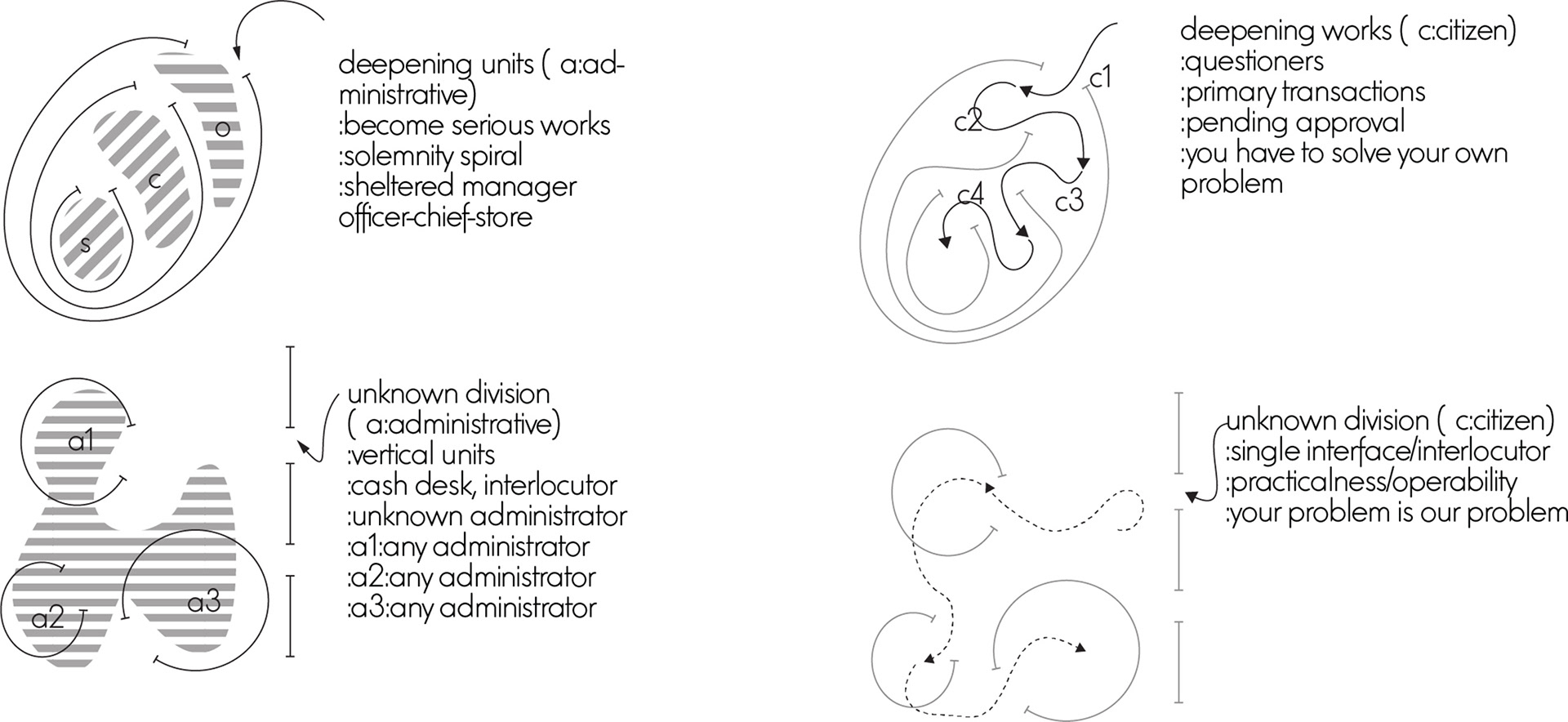

Administrative / service units are not just offices. They are places where public information that originates from being a citizen is included, processed, approved, rejected, activated, or disabled. These are also operative units since their operation comes before space. Thus, this program appears to be reducible to an e-application. It could even improve when its body becomes a web-site. Operation and accessibility seems to be related to the mere existence of the administrative unit, in the internet or in space. Yet, apart from addressing the various administrative procedures, there are functions covered by these administrative units. As a citizen, you are in search for a service that you deserve, and you have a desire for developing detailed narrative forms, beyond assuming an ordinary citizen identity.
These narratives are the media for the production of an individual or citizen and its further conversion into informational forms or documents. Reciprocal efforts are spent, in order to recognize and legitimate and be recognizable and legitimate. A citizenship is declared and its boundaries are drawn up: Citizen who? Who is the regulator? Who is the practitioner? Who has the information? Who says? Who adopts? Via which documents? You believe that the manufacturer, registrar, and practitioner of the right information is this management unit. These are the fields where you interact with spaces, agents, and information, in order to learn about the requirements of the citizenship that you assume and represent, and this learning requires a lived story, a bodily performance.
Car parks are uninhabited places, not to be stayed in. Contingent to the places they are located next to, under, or above, these are places where users are in constant dynamism, where they are in urgent need of evacuation; large fields or volumes that can only be mine for a moment. What is left of the parking lot when the parking lot is removed from commercial areas? It is the start and end point of the actions that are enabled by the vehicle: to go, stop, stay dry, warm up, cool off, listen to music, share a small area with 4-5 people, move, and be isolated. The relationship of the car park to the human body is based on the immediate release of the body. But this is not true for the vehicle. The vehicle tends to stay. The parking lot is an obligatory set up for the substructures of buildings, a building root that extracts humans out of vehicles, and orients them.
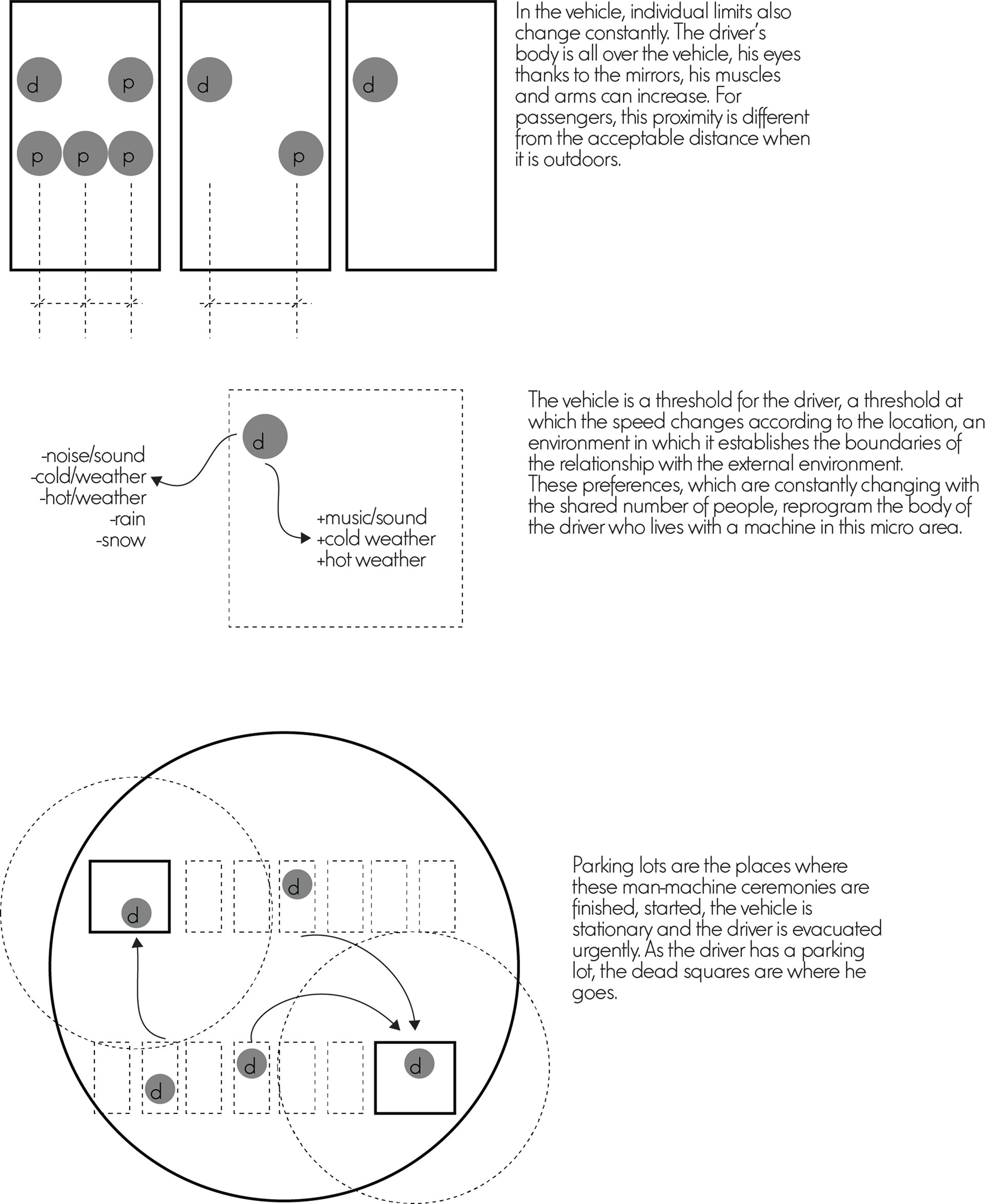
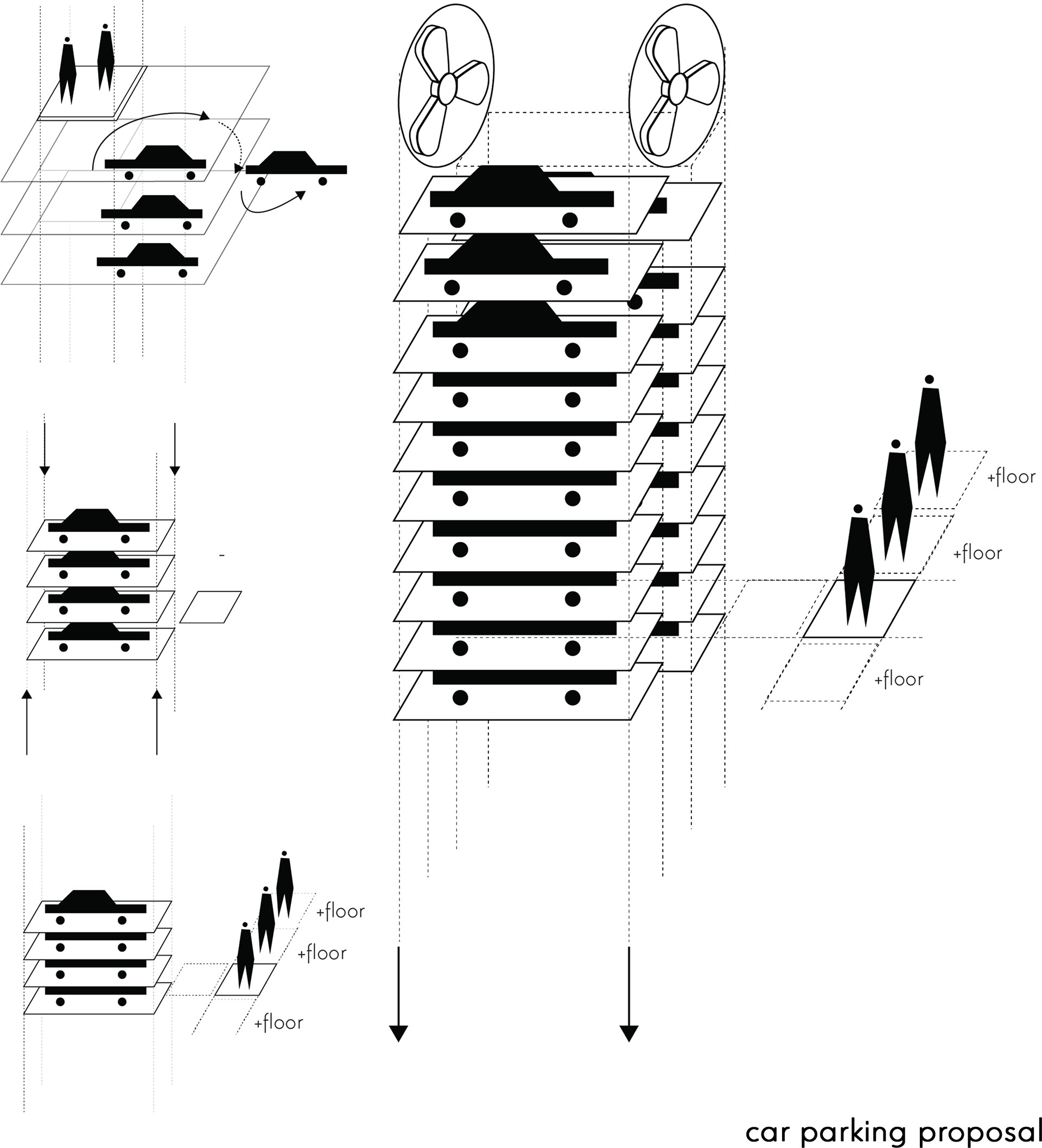
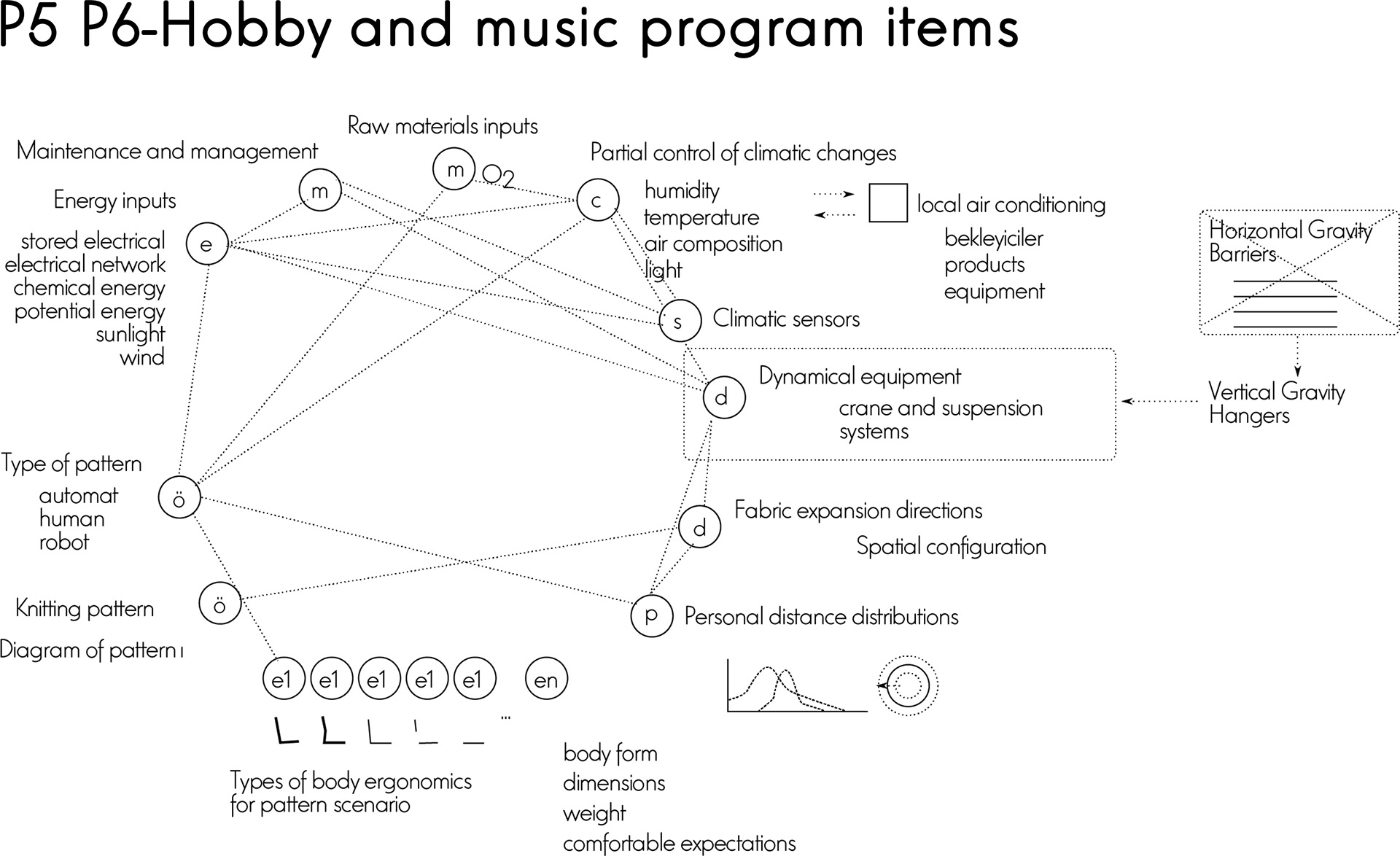
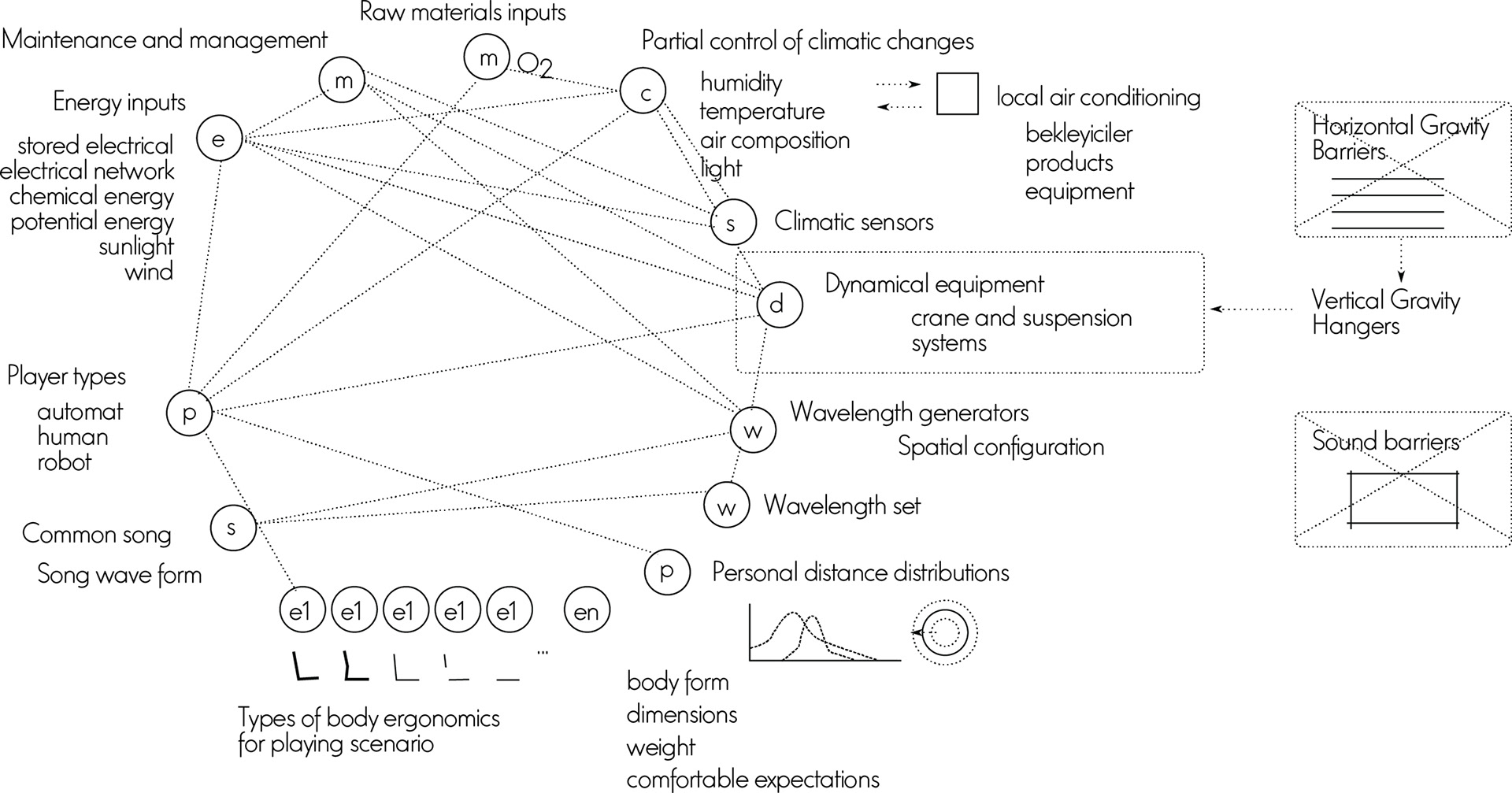
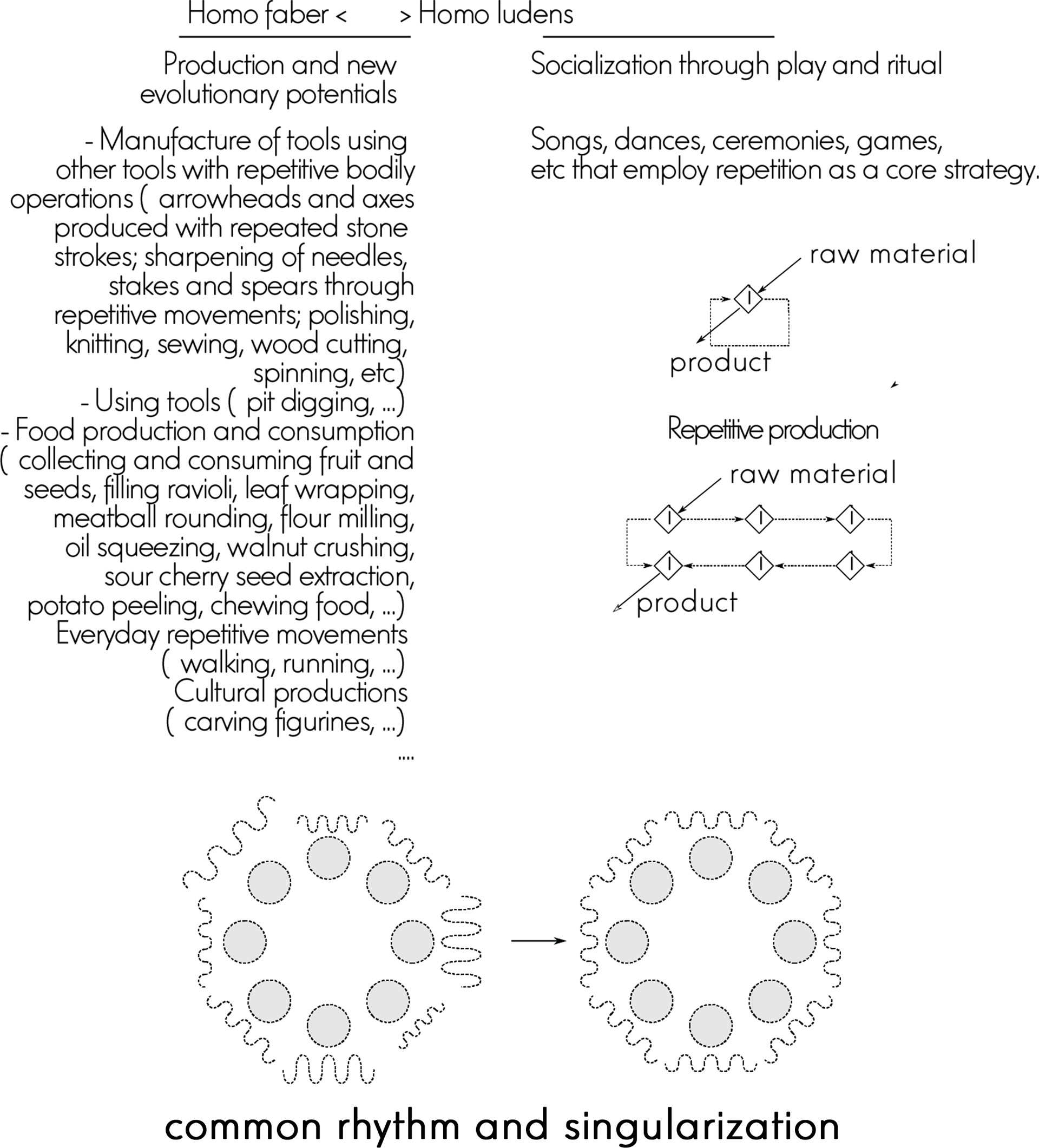
Repetition and rhythm
Dexterity in repetitive work, hand-eye coordination, sensitivity towards the objects of the primary level and the ability to manipulate these are coeval with humanity. The appearance of the human in evolution is marked by stone tools (axe, spear, and arrow). Most hand tools are produced by repetitive actions. Today, the tendency for rhythm and repetition is a remarkable commonality between people. Rhythm and repetition reveal possibilities at different levels in the development of human culture; [Fig. 8] Homo Faber on one side, Homo Ludens on the other.
The reasons for all these actions to be based on repetition constitute a heterogeneous cluster: repetitive application of the power and action that are insufficient or unsuitable to solve the work at once (as in flour milling, wood cutting, and pit digging), the repetitive pattern of the produced object (as in weaving), the requirement of repetition of the interaction between the transformed object and the transforming agent, the large number of transformed objects (such as in the processing of cores, seeds), etc.
Cyborgification
The tool produced by repetition is only partially autonomous, it gains its potential in human use. However, the human, too, is only partially autonomous in its relationship with this tool and it is in loss without that tool. Since the first stone axe has been produced, the human is a cyborg in the literal sense.
“Zeki Müren Eyelashes” as a virus
In the repetitive production of a pattern, the hand, the tactile, kinesthetic, visual sensors, and related cognitive processes become devices of the production diagram of the basic component of the pattern knitted with crochet or skewers. The consciousness closes off in this region, the flow begins. The sensorimotor regions of the brain capture the bodymind in an autonomous activity that is closed to consciousness. The diagram of the work takes over the body. As a result, the person partially becomes a zombie, controlled by the diagram of the repetitive work.
Diagram can also be seen as a virus. It begins to indefinitely replicate and reproduce itself, through partially capturing the individual bodyminds, social setups, and the tools that create the environment. A concrete evidence of the notion of “memes” can be such diagrams with their concrete outputs.
Repetitive actions as the base of mechanization
Repetitive action follows a diagram. The skilled artisan describes a diagram of a workflow that a machine can now undertake, when a perfect flow is provided, between the materials to be transformed, the body components, the sensorimotor zones of the mind, the tools, and the environment. Such a production diagram is not dependent on a specific person or environment, it can be reproduced in many different people and machines, and this means that it will produce many different subjects and machines, the agent is the diagram.
Diagram of production as agent
The human's production is an evolutionary advantage. Predisposition to repetitive production is selected and the human is mechanized for manufacture. And in an environment where repetitive production is perfected, machinery becomes capable of undertaking all tasks. The basis of the industrial revolution is repetitive production. The real actor is not a gene but a specific production that provides evolutionary advantages and leads to the selection of genes. That production bootstraps itself from its very diagram. Repetitive jobs reaching this level are undertaken by machines. The work is the same, while the environment is changed. The ontological basis to stay relatively constant is the diagram of the activity.
Flow, trans, automatism
Handcraft and music can be understood as diagrammatic rituals. In these ceremonies, cognition is focused on the motor region, hand-eye-ear, proprioception, and coordination of motor functions become an unconscious loop and seize the bodymind. In the moment of trance, while the person rhythmically marks time, the explicit representation of time is lost in the mind. Such automatic repetitive actions that are colloquially called "flow", establish a link between work and pleasure. Repetitive production is both work and fun, and entertainment can also take the model of repetitive production.
Sense of community
It may be necessary or enjoyable to have a common rhythm in common jobs, or in jobs done next to each other. Acting in a common rhythm dramatically proves that people are aware of one another and are related to each other. Gathering around the fire, producing and consuming the food with repetitive movements, conducting the nighttime work with repetitive movements, repetitive rituals, songs, and dances not only emotionally connect people with each other, but make them resonate26. Furthermore, these can literally unify the people, make a single dynamic object out of them, which moves synchronously. The ritual can capture a group of people on behalf of a single repetitive movement (dance component / diagram) and make them robots.
Hobby spaces from the point of view of “Zeki Müren Eyelashes”
Hobby spaces should be configured from the point of view of specific cultural patterns or focus on the production of these patterns in different environments. The external actors which operate these will have to be effectively coupled to the diagram of its production. Zeki Müren Eyelashes is a popular weaving and embroidery motif, and traverses various levels of the commons. It does not matter whether knitters, machines, robots, 3D printers or people operate this space.
Music studios from the perspective of the song, “Milky Way”
The notes of a song express a regularity and universality based on wave patterns, which is sensible by most humans. The rhythm, likewise, operates in the mind, albeit in a different way. Any song can be resolved to simple sinusoidal waves through the Fourier transform. When the components of the space begin to produce the temporal transformations in these wave distributions, the song will begin to be performed by the venue. The venue will become the song. What drives the wave generators is irrelevant. The actuators can be winds, animals, mechanical or electronic systems, human limbs or toes. [Fig. 11] The action is rhythmic in all cases. The generation of certain sound waves can be based on simple cyclic movements, but may also be made to require intricate motion sets. The wavelengths produced by the mechanisms have to catch the correct rhythm and capture the subtle fluctuation of the music. The music of this space requires a masterful search for synchronization.
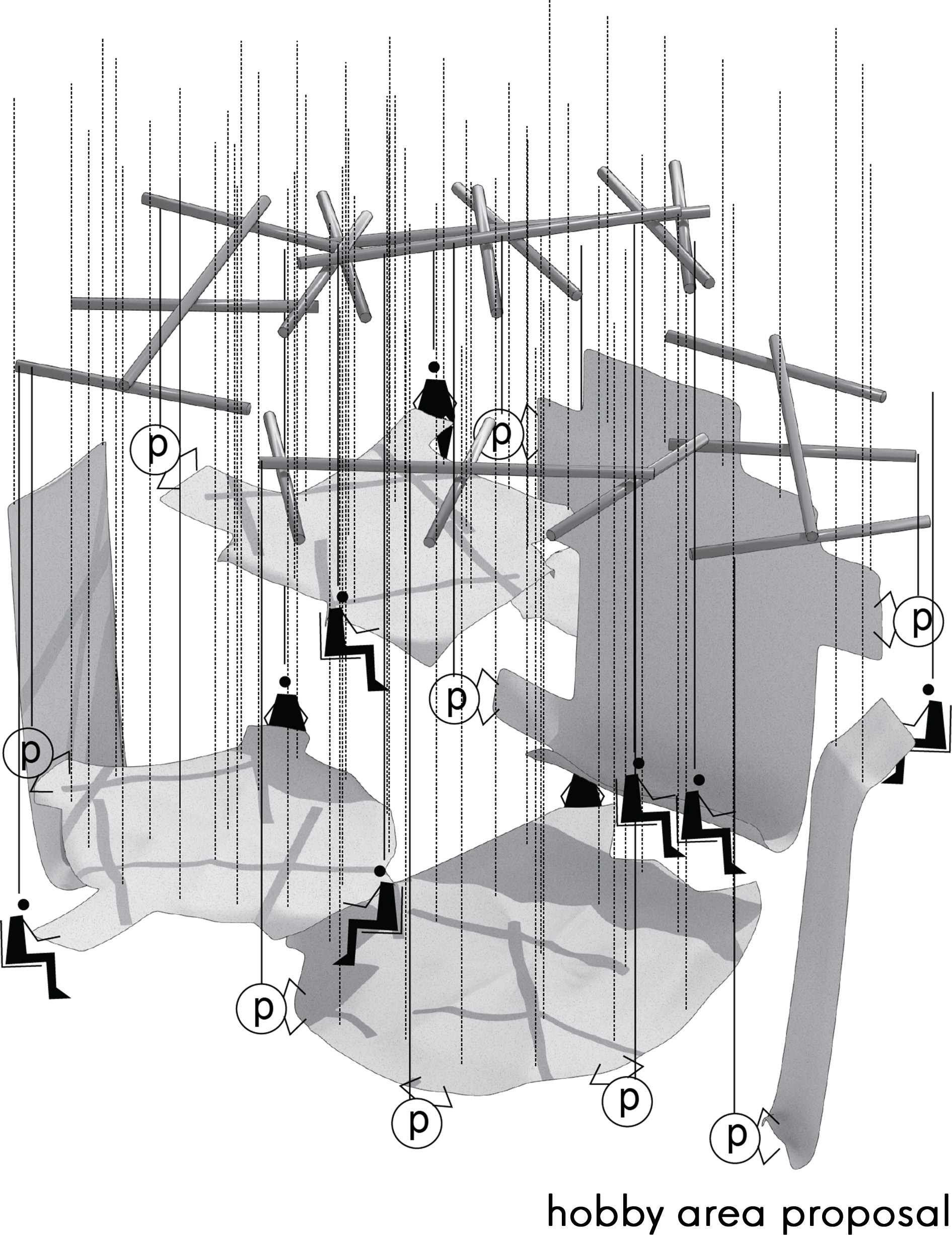

In its traditional conception, the performance hall is a program, which tries to homogenize the relationship of the viewers with the scene, the sounds, and images. It stacks the bodies in concentric circles, in order that a stage, together with distribution gradients for bodies and sensors (eye, ear, etc.) are constructed. A diagram that manages each vision sensor to gain a certain degree of visibility governs the gradient of the body positions. Even though the horizontal distribution of bodies has been a priority, the vertical stacking techniques in the form of balconies and loggias have been common in large halls. In very large halls, the viewing angles can separate the seating groups into patches. The acoustic organization forms a second diagram-space layer that aims at the homogenization of the sound distribution without affecting the seating pattern. This acoustic diagram is more legible than the body-and-viewpoint diagram, since it governs sound waves, instead of bodies.
The formation of decor and stage can be understood through an “attractor” metaphor. A sofita system manages the decor curtains, which can switch between a series of attractors, or preset combinations. The stage and the hall meet on one plane. This plane is divided into the stage and backstage by the curtain system. The lights separate the stage and the audience area. Viewers can participate in the show from this area to the extent that is allowed by the arrangement. They can enter the scene and return to the viewer area. Light and sound sensors can be assumed by artificial mechanisms as well as traditional organisms. A camera set that simulates an ideal tribune arrangement broadcasts for people and systems who attend through VR. Each seat can be occupied by many observers. People who participate in the event via VR can place their bodies in their homes or they can choose to get stacked in various seating positions offered by the body storage volume.
The cinema can be reduced to a single person as long as it frees from external stimuli and creates an isolated image. The body is abstracted on its own, for which dedicated foods are produced. Popcorn is a cinema dinner; its grains can develop an arresting rhythm of hand-mouth coordination. In order for cinema visuals to be dominant, other senses are attempted to be reduced. Technology is geared to capture the human being, trying to retain the human within its center. As a space, the cinema is formed to sustain this focus. Not only visuals, but also sounds increasingly begin to take part in this containment and focusing. The cinema audience surrenders to the screen, the vision, which is screen-centric, goes beyond all other senses. The body is now a mass of targeted senses. It does not matter where it stands. It will surrender itself to inaction, in order to prevent the lifting of the blockade. As in every performance, the body is in the mode of a stock.

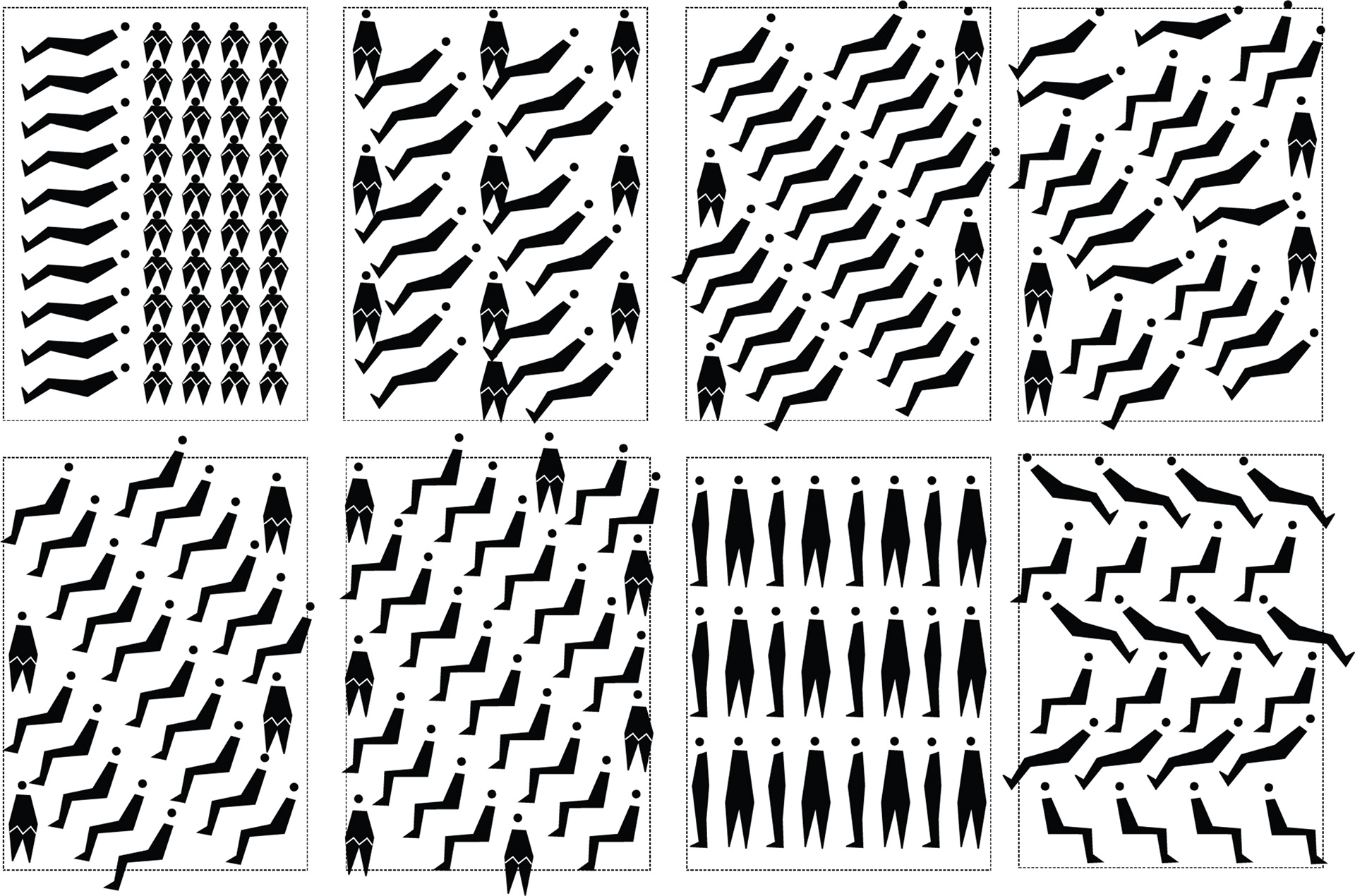

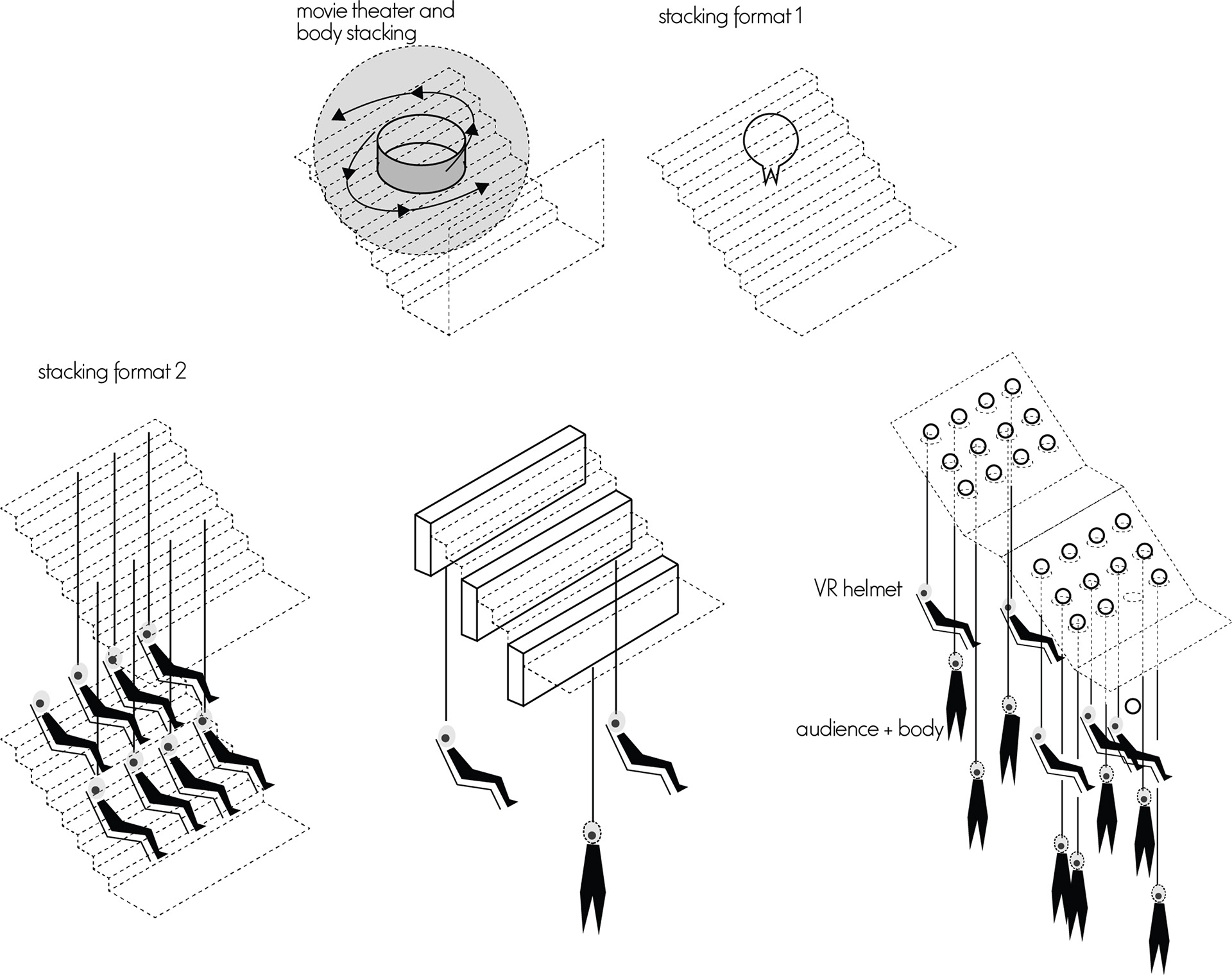
1. Capturing [customerization] ceremonies: Desires, needs, expectations
A shop window display has a sustained effect on me. The interior of the store glides through this screen and enters into my visual field. The setting is founded to “customerize” me, while I am there to get captured; I consider customerization. However, this interaction cannot be explained only by the elements that are present there. A whole geography of advertising, marketing, social status, needs that are beyond the person play their roles. This effect develops in the person before, below, inside, as part of an affective topography of desires, needs, and expectations. The interaction is not unidirectional towards the person, as the data that people provide at other times will create a complex feedback loop that affects the showcase, product, brand, and communication strategies. In the process, the only action that can be consummated by the body, which is regarded identical to the traditional person, is to pass the threshold of the store. When I cross the threshold, both the shopkeepers and I move on to perceive myself as a customer. I become part a series of familiar ceremonies. I am expected to follow a scenario. I am reduced or shaped into an entity that is to be understood and interacted only within the codes of this scenario.
2. Exchange and problem-solving ceremonies: Properties and economic assets
Cash register, money exchange, customer service etc., such interaction types make it clear that the core person (the bodymind traditionally seen as the individual's bearer) is not equal to the customer. While the economic assets to be operational at this point are additions to the bodymind, the way in which the bodymind is qualified as a client is directly dependent on these assets and the extent to which they are mobilized. The exchanges in the cash register abstract out and reduce the individuals to their economic assets. The narratives of the various identities that are traditionally seen as significant in making up our identities become as negligible as the bodymind. Rather than seeing this as a kind of alienation, it would be more appropriate to understand this as one of the proofs of the originary multiplicity and distributedness of human beings. The individual is an impossibility, it is a multitude of systems. Each systemic situation, for example, the programmatic moments analyzed here (moments of ceremonies), will interact with a different layer of the person.
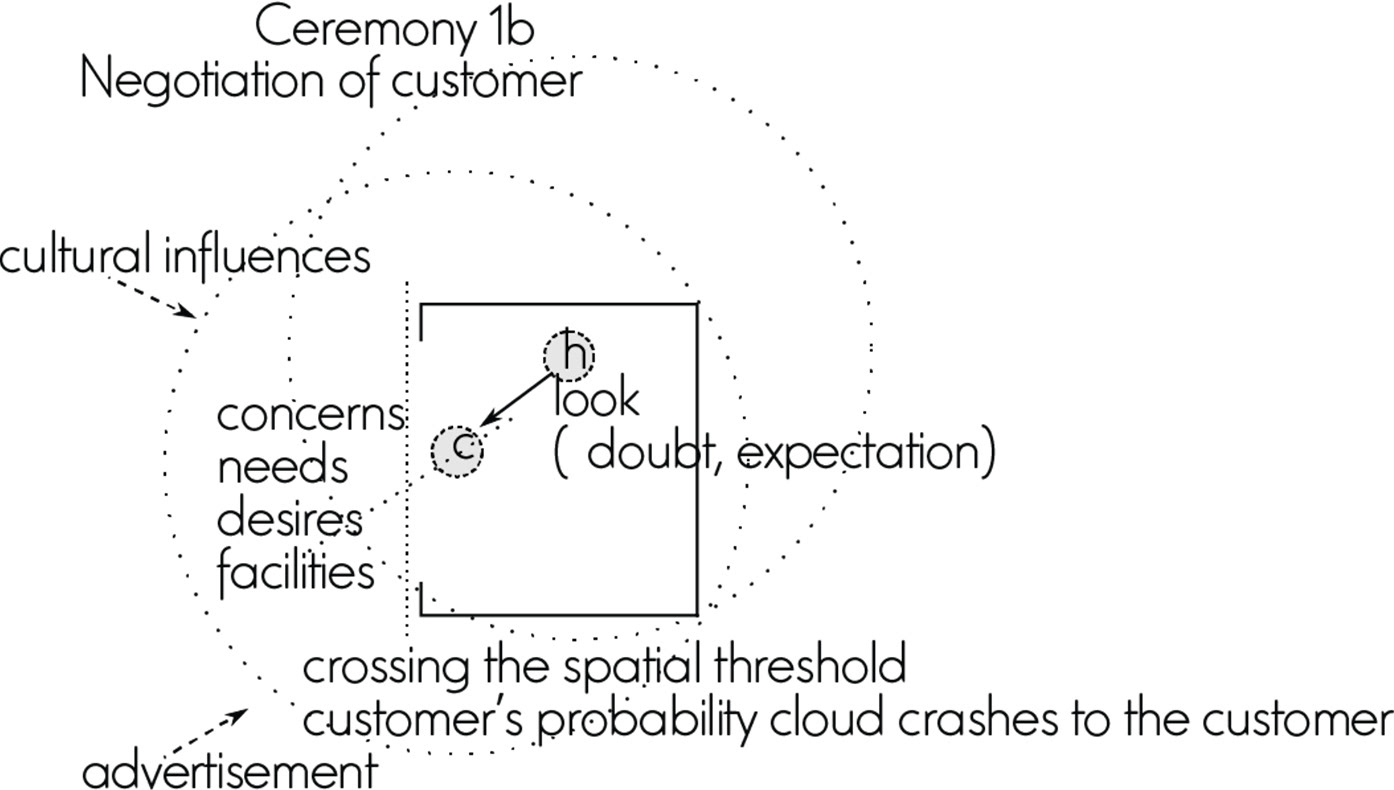

3. Manipulation and facilitation ceremonies: Desires, concerns
What is a person? Neither narrative understandings, nor fictions on the viewpoint soul, nor the bodymind, nor legal specifications consume the person. The client observed by the clerk can only be understood by the customer function, not as how she/he understands himself/herself. It is initially composed of various intentions and a body location. Intentions may be shopping-related or suspicious. The shopkeeper will also be prone to understand itself not through friendship or family narratives, but with its function in this ceremony. The moment it interacts with the customer (How can I help you? Did you like it? ...) the observation ceremony evolves into a manipulation scheme. Manipulation brings the handles to the foreground. The handles are our desires that push us into customerization and our concerns about how we are perceived. Simultaneously, the client makes its opponent a shopkeeper and asks for its help. Both symbolic centers are reluctant to interpret each other's identity from a wider frame with various layers. The whole cloud of possibilities of human relations collapses into an extremely limited ceremony.
4. Interaction with the product: Body parts
A garment interacts with parts of the body. A tailor is occupied with the components of a specific body. A clothing manufacturer on the other hand is concerned with generic body types, rather than a particular body. The customer's interaction with the product is initially reduced to the interaction of the piece of clothing and the body part to which it corresponds. On a higher level, the contextual relation of these garment pieces to other garment pieces and on a still higher level the contextual relations of the ceremonies targeted by the garment configuration are taken into account. The garments, which are perfectly known to be auxiliary, contingent, additional, annexed, which are to be taken off at night, magically become the most important components of identity. In many vital ceremonies the identity is almost totally transferred to the garments, or in other words, the garments undertake to describe the person. What can demonstrate the partiality, accidentality, and distributedness of identity more dramatically than this?
